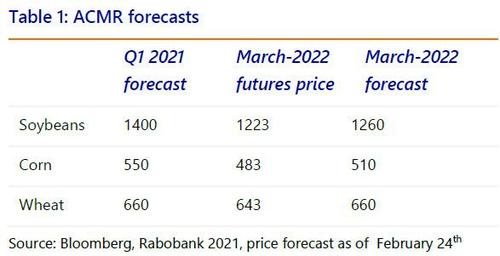
Biblical, Lean, and Mean: ‘Dreams’ of an agri-commodity super-cycle
Then Pharaoh said to Joseph: “Behold, in my dream I stood on the bank of the river. Suddenly seven cows came up out of the river, fine looking and fat; and they fed in the meadow. Then behold, seven other cows came up after them, poor and very ugly and gaunt, such ugliness as I have never seen in all the land of Egypt. And the gaunt and ugly cows ate up the first seven, the fat cows. When they had eaten them up, no one would have known that they had eaten them, for they were just as ugly as at the beginning. So I awoke.”
– Genesis 41:17-21
- Key feed and food prices have been pulled to 9-month and 7-year highs
- We explore the ‘dream’ of Biblical scarcity; its origins and impacts; and draw comparisons with Joseph, the trader and central planner who avoided starvation for ancient Egypt
- One point is clear: global food insecurity falls heaviest on lower income, importing nations, who spend a far greater share of their income on food than the richer ones
- The Fed would play an ironic role in this process even as it embraces fighting poverty and inequality alongside inflation
- This could exacerbate (geo)political risk – potentially even regarding institutional architecture
Our Base Commodity Call
At time of writing, our forecasts for three of the world’s key agri commodities, soybeans, corn, and wheat are as follows:

The First Big Commodity Call
In the Bible, Joseph interpreted Pharaoh’s dream as meaning great abundance for seven years would be followed by an equal famine. He was then entrusted with ensuring Egypt’s storehouses were full of grain so the country could survive – which he, and it, did.
In short, Joseph made the first agri commodity cycle call, where survival came before profits. Today we have seed technology, automated agriculture, and global markets. Yet we still have lean and fat years for reasons meteorological, logistical, political, and geopolitical. This report will try to do several things:
- Summarise price action in key agri commodities to consider if we are seeing anything unusual – we will show we are, reflected in our elevated base price forecasts;
- Disaggregate and define the main drivers of these price movements. While the agri market is very old, new developments could produce striking new price patterns;
- Imagine what a Biblical scarcity would look like, putting forward simplified assumptions to estimate what each of them in isolation could do to food prices;
- Look at global food insecurity to ascertain how many countries are suffering already and would do so in the scenario that prices rise higher; and
- Consider the worrying (geo)political implications.
1) Supplies Shaken, not Stored
For key feed and food commodities, the message for markets and institutions is a simple one: they are going up. The S&P global agricultural index is up for a 9th straight month, to its highest level in 7 years (see Figure 1). Even though we are coming off a low base of comparison, which helps the base effects, the last period to see such a rapid rise was 2011, and prior to that 2007.

 How Crypto Works?
How Crypto Works?  Why Is Crypto Down? The Truth.
Why Is Crypto Down? The Truth.  Cleveland Clinic Bans Severely Ill Ohio Man From Kidney Transplant Because The Donor Isn’t Vaccinated
Cleveland Clinic Bans Severely Ill Ohio Man From Kidney Transplant Because The Donor Isn’t Vaccinated  LOUISIANA WILL EXPUNGE YOUR CRIMINAL RECORD IF YOU AGREE TO GET VACCINATED
LOUISIANA WILL EXPUNGE YOUR CRIMINAL RECORD IF YOU AGREE TO GET VACCINATED  Kraft Heinz CEO says people must get used to higher food prices
Kraft Heinz CEO says people must get used to higher food prices 


